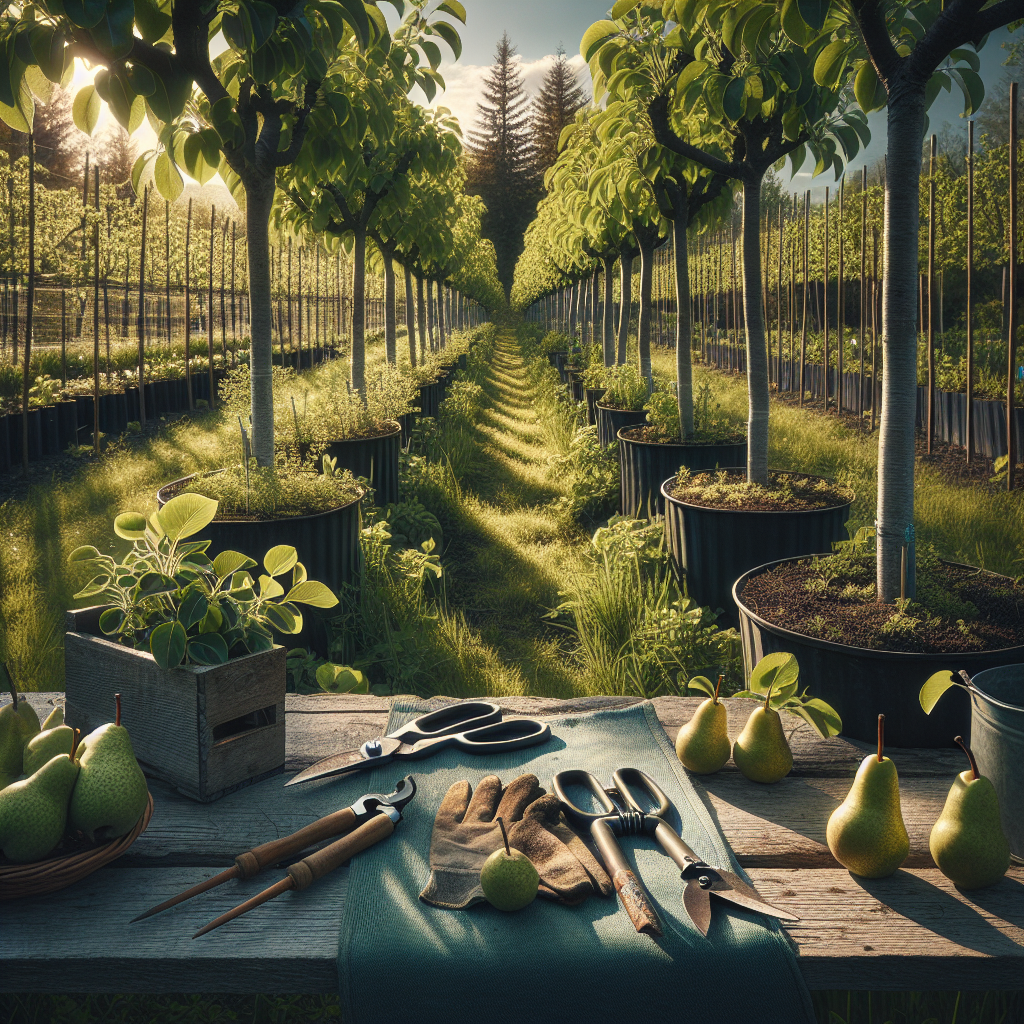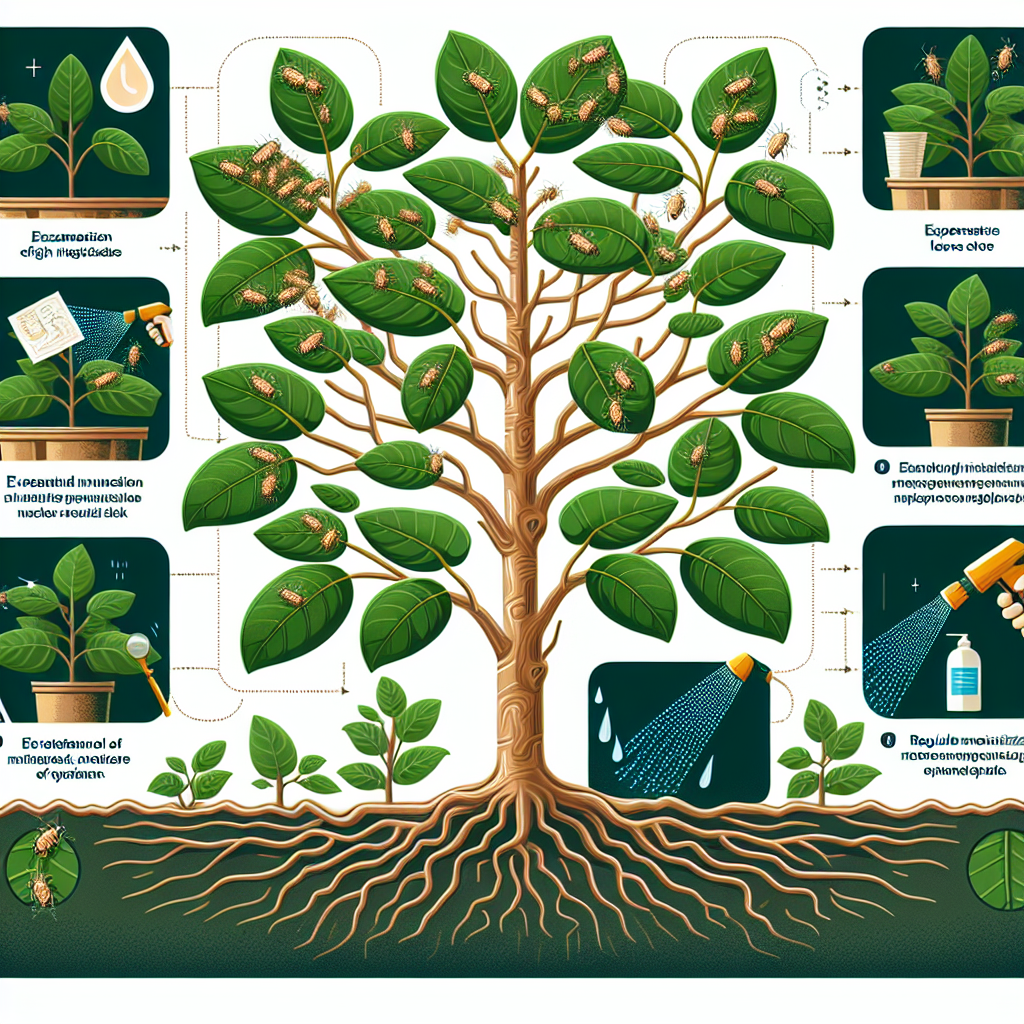Training Young Pear Trees for Maximum Yield
Updated October 20, 2024 at 12:17 am

Introduction to Young Pear Tree Training
Growing a pear tree in your backyard can be a joyous and fruitful endeavor, literally. Whether you are a seasoned gardener or a budding horticulturist, understanding the nuances of pear tree care, particularly in its formative years, can lead to a bounty of sweet rewards. Initiating proper training techniques for young pear trees is crucial for maximizing yield and ensuring the overall health of the tree.
Understanding the Basics of Pear Tree Cultivation
Before we dive into the tree-training specifics, it’s important to grasp the basic needs of pear trees. These trees thrive in zones 4 through 9 and prefer well-draining soil with ample sunlight. Providing a conducive environment is the first step towards a flourishing pear orchard.
Essential Overview of Pear Tree Needs
-
Pet Friendly
Pear trees are generally safe for pets. There aren’t typically concerns for toxicity, making it a stress-free choice for owners of furry friends.
Light Requirements
Young pear trees require full sun to produce the best fruit. Aim for at least six hours of direct sunlight daily.
Watering
Consistent moisture is key, especially during the tree’s early years and drought periods. However, avoid over-watering as this can lead to root issues.
Humidity
Moderate humidity is best. Pear trees can tolerate a range of conditions, but excessively high humidity may promote fungal diseases.
Temperature
Young trees are vulnerable to frost damage. Protect them during unexpected cold snaps. Mature trees are cold hardy and flourish in temperate climates.
Difficulty
With the proper care strategies, growing young pear trees is a moderately easy task that can be highly rewarding.
Choosing the Right Young Pear Tree
When starting out, your choice of tree will set the stage. Opt for varieties known to perform well in your climate. Bartlett and D’Anjou are popular for their flavor and reliable yields. Visit a local nursery to select a healthy sapling with a vigorous root system—a vital component for a strong foundation.
Planting with Care for Future Success
Planting is more than digging a hole and burying roots. Ensure you provide ample space for growth, both above and below ground. A common guideline is to allow about 20 feet between trees and away from buildings or other structures. Place the tree in the hole so that the graft union is just above the soil line, then backfill with a mix of local soil and compost to encourage robust growth.
The Importance of Pruning in Pear Trees
Pruning is a critical aspect of pear tree care. Begin in the dormant season following planting. Establish a strong central leader and prune away any competing shoots. This encourages a well-spaced, scaffold branch system that allows light and air to penetrate, reducing disease risk and fostering better fruit production.
Selecting and Using Proper Pruning Tools
The right tools make all the difference in pruning. For young trees, quality bypass pruners like the Felco F2 Classic Manual Hand Pruner offer precision cuts without crushing delicate branches. Based on numerous reviews, its reliability and clean cutting action make it a favored tool among gardeners.
Find This and More on Amazon
Structural Training for Longevity and Yield
Training involves directing growth to ensure structural integrity and optimal fruiting. For pear trees, this usually means selecting a few strong branches for the tree’s framework. Aim for branches with wide angles to the trunk, as narrow angles can weaken over time and are more prone to breaking under the weight of fruit.
The Role of Thinning in Maximizing Pear Production
Thinning is the deliberate removal of some fruit to improve the size and quality of the harvest. Perform this task in early summer after the natural fruit drop. Aim to leave about 6 inches between remaining pears to avoid overcrowding and to promote larger, healthier fruit.</p
Trellising and Support Systems for Pear Trees
Support systems such as trellises or stakes are often necessary for young pear trees to prevent damage from wind or the weight of the fruit. Trellising also aids in maintaining the desired shape of the tree and can be especially helpful in small gardens where space is a premium. A well-regarded option is the Gardener’s Supply Company Sturdy Stretch Tie, which is gentle on the young branches yet provides dependable support.
Find This and More on Amazon
Fertilization: Feeding Your Pear Tree for Growth
Fertilization provides the necessary nutrients for your pear tree’s growth and fruit production. In the early stages of your tree’s life, a balanced fertilizer is recommended. As per customer feedback, products like Osmocote Smart-Release Plant Food Flower & Vegetable are favored for their ease of use and effective nutrient delivery.
Protection from Pests and Disease
To safeguard your young pear tree from pests and diseases, routine monitoring and preventive measures are essential. Organic options, such as neem oil, have been noted in reviews for their effectiveness against a variety of pear tree afflictions without harming beneficial insects.
Learning from Common Mistakes in Pear Tree Training
Avoiding common mistakes is as crucial as following best practices. Over-pruning, neglecting to thin fruit, or improper watering can all lead to unsatisfactory results. Learning from others’ experiences can help you sidestep these pitfalls and ensure your pear tree thrives.
Winter Care: Preparing Your Pear Tree for Dormancy
Young trees need protection from winter’s cold. Adding mulch around the base of the tree can help insulate roots, but be sure to keep it away from the trunk to prevent rot. Some gardeners also use burlap wraps for extra protection against frost damage.
Harvesting: Recognizing When Pears are Ready to Pick
Knowing when to harvest pears can be tricky, as they ripen off the tree. Look for a slight softening and a change in color as indicators. When picked at the correct time, pears can be stored for extended enjoyment, providing a delicious payoff for all your hard work.
Year-Round Pear Tree Care Calendar
Maintain a year-round care calendar for your pear tree to keep track of pruning, fertilization, and other key tasks. This helps you stay organized and ensures that each critical step in pear tree care is performed at the optimal time, resulting in healthier trees and better yields.
Advantages of Growing Pear Trees at Home
Aside from the delicious fruit, growing pear trees at home has numerous benefits. It can offer a sense of accomplishment, therapeutic value, and the opportunity to teach children or grandchildren about the cycle of growth and the importance of caring for the environment.
Conclusion: Patiently Cultivating Your Pear Tree
Growing pear trees requires patience and dedication, but the outcomes are well worth the effort. By understanding the needs of your young pear tree and providing the right training, care, and support, you are on the path to enjoying abundant harvests for years to come.
Maximizing Fruit Size and Sweetness in Pear Trees
Cultivating the perfect pear goes beyond just a strong tree structure; it is also about the taste and size of the fruit. A technique to increase these desirable traits is consistent watering and utilizing natural sweeteners like organic molasses during the growing season, which helps to enhance the sugars within the fruit.
Regular taste tests during harvest season can provide a good indication of the fruit’s sweetness levels. This empirical approach combined with soil amendments based on your orchard’s specific needs can improve not only the health of your pear trees but also the taste and size of your pears.
Innovative Pear Tree Training Techniques
Nowadays, gardeners employ various innovative techniques to train their pear trees. Espalier—a method of training trees against a flat surface—is both decorative and space-saving. This technique can also make it easier to cover trees with protective netting or fleece to ward off pests and shield from harsh weather conditions.
Another modern approach involves the use of growth regulators to control the tree’s growth patterns. This helps to ensure more energy is invested in fruit production rather than excessive foliage growth, though this practice should be conducted with guidance for optimal results.
Understanding Soil pH and Its Impact on Pear Trees
The role of soil pH in the healthy growth of pear trees is often underrated. Pear trees prefer slightly acidic to neutral soil (pH 6.0 to 7.0). Testing your soil’s pH and amending it can prevent nutrient deficiencies that may affect tree vigor and fruit quality.
Products like the Luster Leaf Rapitest Soil Test Kit have been recommended by gardeners for their user-friendliness in testing soil pH, as well as nitrogen, phosphorus, and potash levels, which is crucial for tailoring your fertilization practices to your tree’s needs.
Find This and More on Amazon
Organic vs Synthetic Fertilizers for Pear Trees
When it comes to fertilization, the organic versus synthetic debate is ever-present. Organic fertilizers release nutrients slower and improve soil structure, while synthetic fertilizers offer a quick-fix nutrient boost. Consider products like Jobe’s Organics Fruit & Citrus Fertilizer with Biozome, which promotes healthy root development and richer fruit harvests while being eco-friendly.
However, every orchard is different. The choice between organic and synthetic should be based on your soil’s needs, sustainability practices, and personal preference.
Irrigation Tips for Young Pear Trees
Effective irrigation is more than just watering your trees. It’s about providing the right amount at the right time. Pear trees benefit from deep watering, which encourages deep root growth. A popular tool to assist in this is a soaker hose, which delivers water directly to the roots with minimal wastage.
Keep in mind that young trees are more susceptible to water stress, which can affect fruit set. Monitoring soil moisture levels and adjusting irrigation accordingly can help maintain an optimum balance.
Understanding Pear Tree Diseases and How to Combat Them
Familiarizing yourself with common diseases like fire blight or pear scab, and understanding how to manage them, can save your pear trees from hardship. Fungicides such as Bonide Liquid Copper Fungicide concentrate are often cited in reviews for their effectiveness in treating fungal diseases when used appropriately and as part of an integrated pest management plan.
Remember, prevention is better than cure, so adhering to good orchard hygiene practices and selecting disease-resistant pear varieties can help minimize the risk of these problems.
Integrating Wildlife into Your Pear Tree Orchard
Attracting wildlife such as birds and beneficial insects can assist in maintaining the ecological balance in your orchard. Birds naturally reduce pest populations, while bees are essential pollinators for producing fruit.
Creating a habitat that encourages these allies, whether through planting companion flowers or installing birdhouses, can be an effective and natural way to enhance your pear tree’s health and yield.
The Joy of Pear Tree Blossoms
Pear tree blossoms are not only beautiful but also a sign of future fruit. The delicate white flowers that adorn the branches in spring are crucial for pollination. Ensuring good pollination by having compatible pear tree varieties or by attracting pollinators will set the stage for a bountiful harvest.
Enjoy the aesthetic allure of the blossoms knowing they are the precursor to the delicious pears you will harvest in the fall. It is these moments of natural beauty that make growing your own fruit trees a truly rewarding experience.
Final Thoughts on Training Young Pear Trees
Training young pear trees takes time and attention to detail, but it is a labor of love that can bring great satisfaction. Through your journey, remember to observe, learn, and adapt. Each tree is unique, and every growing season offers new lessons. With the right knowledge and dedication, you can enjoy the fruits of your efforts for many seasons to come. Whether you find solace in the delicate blossoms of spring or take pride in a bountiful autumn harvest, pear trees can offer both beauty and taste, making them an invaluable addition to any garden.
Shop more on Amazon

